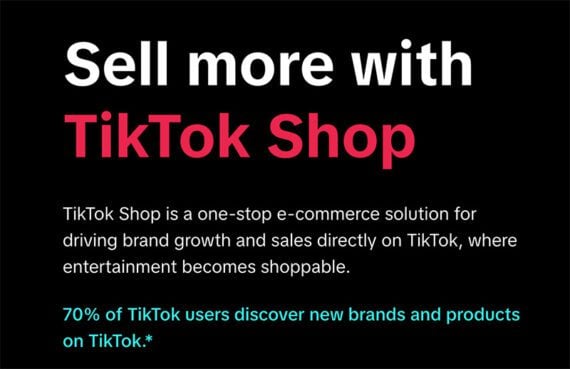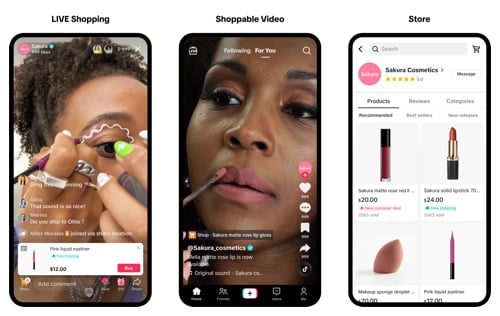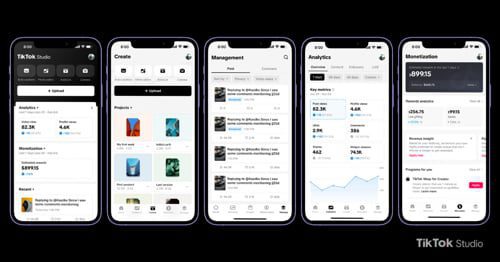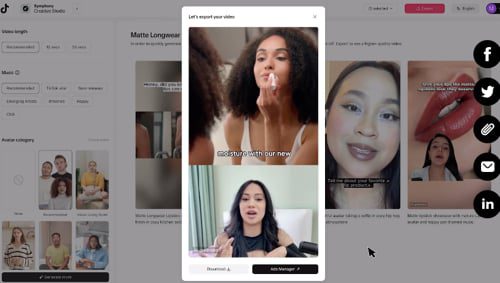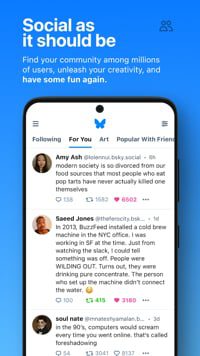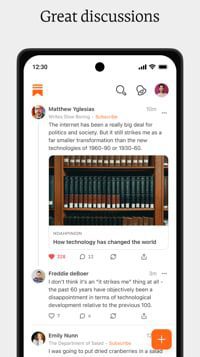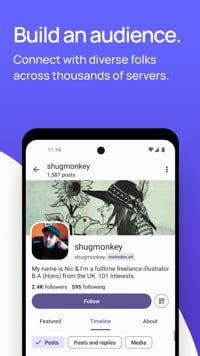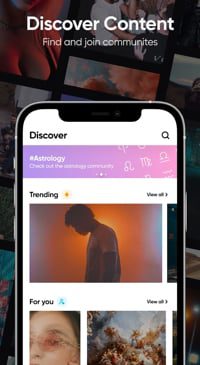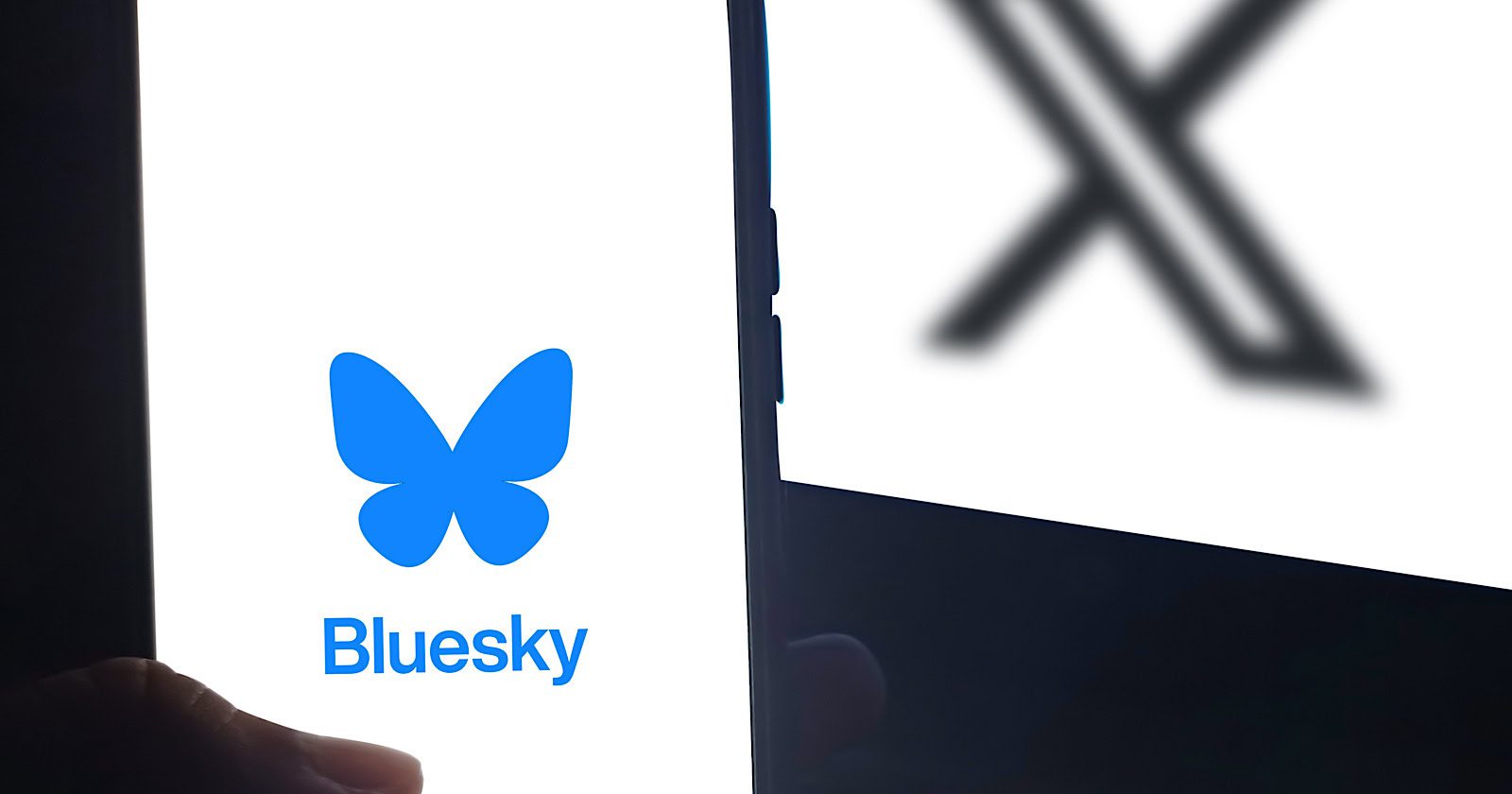Thankfully, every so often, a tool comes along that makes the complex world of search engine optimization a bit more manageable.
Social bookmarking sites are one of these tools that can be your new best friend in the SEO landscape.
Why are they so crucial? Simple: They’re powerhouses for building links, which are vital for SEO success.
Think of social bookmarking sites as your personal digital librarian. They let users discover, categorize, and store webpages all in one place using virtual “bookmarks.”
Social media platforms like Pinterest have revolutionized how we think about social bookmarking, proving themselves as essential tools in any marketer’s toolkit.
And it’s not just about generating any links; it’s about crafting quality connections that boost your visibility on search engines.
Sure, most of these links are nofollowed. However, the traffic and visibility they bring can catapult your site to the front page of search results.
But remember, there’s more to it than just links. Search engines use these sites to gauge the relevance and value of content. So, while you’re getting your name out there, you’re also building credibility and authority.
If you’re curious about which sites to start with, this guide has you covered.
Take a look at my list of the top 140 social bookmarking sites that are perfect for getting your content noticed and shared.
My Top 24 Social Sites (In No Particular Order)
1. X
X (formerly Twitter), despite what you may have heard, is still huge. In fact, the platform has over 500 million monthly active users.
While it might not be the first site that pops into your mind for submitting content, it has a large audience and is an efficient platform for posting.
Many people use it to post links, content, and images that they find interesting and worthy of a revisit in the future.
2. Pinterest
As the quintessential social bookmarking site, Pinterest has an average monthly user base of 498 million, roughly 72.6 percent of whom are female.
Furthermore, users are pinning over 1.5 billion Pins per week to more than 10 billion Pinterest boards.
3. Mix
In June 2018, the popular discovery platform StumbleUpon became Mix.
Mix lets you experience the internet as curated by machine learning, editors, or publishers.
You can also tag content that you liked, in particular, to share with others.
4. Slack
Slack is a group messaging program that provides users with customizable channels in which chats can occur.
You can also create private groups, and have direct messaging. I, personally, have found tremendous value in groups like The SEO Community and The SEO for Journalism groups.
In 2022, Slack had an estimated 35 million users.
5. Notion Community
Notion Community is a platform for users of Notion, the all-in-one workspace for note-taking, project management, and data organization.
The community allows users to share templates, setup tips, and best practices on using Notion effectively.
It’s perfect for productivity enthusiasts, project managers, and anyone interested in personal or professional organization.
This community helps individuals improve their workflow while connecting with others who use and customize Notion in innovative ways.
6. Pocket
Appropriately named, when you put something in your Pocket, it’s there to be found later.
Users of Pocket can hold onto anything they find on the internet or through various apps.
Bonus points for the fact that once something’s in your Pocket, you don’t need an internet connection to access it.
7. Digg
Got great content?
Then it belongs to Digg.
Digg is an addictive social bookmarking site that’s perfect for sharing your captivating content with a highly engaged audience.
8. Folkd
The Folkd bookmarking site contains a unique social search feature that works much like a typical search engine, except the results don’t come from a complex, machine-driven system of analytics.
Instead, top results display quality content that Folkd users have bookmarked.
The more saves a piece gets, the higher its rank in their social search, which helps connect their visitors with even more quality content.
9. Reddit
What can’t be found on Reddit?
Users generate threads that can then be commented on, upvoted, or downvoted, and it is a great tool when you’re looking to quickly promote content, generate content ideas, or get answers to a question.
It’s also now one of Google’s key AI training data sets.
10. Fark
One of Fark’s best attributes is their commitment to quality.
As a social networking news site, Fark receives mountains of submissions on a daily basis but presents only the best to their audience.
This site isn’t for wimpy, weak content.
But, if you’re ready to showcase your talent and drive traffic to your own site, Fark is the way to go.
11. BizSugar
If you’ve got content about startups, marketing, and the world of small business, then BizSugar is the social bookmarking site that will help build your reputation and brand authority in a growing community of like-minded small business professionals.
12. Slashdot
Slashdot is the ultimate bookmarking site for tech geeks and the techie at heart.
Users of Slashdot submit and share content on gaming, cloud computing, computer hardware, security management, and more.
13. We Heart It
While users can submit and bookmark different types of content, We Heart It is heavily visual.
The app is nice to look at, easy to use, and inspirational – especially for anyone who loves great imagery.
14. Scoop.It
This site, aimed toward professionals, offers solutions for content creation, content curation, predictive analysis, and content intelligence.
Scoop.It offers four different platforms – a free version for individuals, as well as three paid options: Pro, Plus, and Enterprise.
15. Elpha
Elpha is a social network tailored specifically for women in the tech industry, providing a space for networking, job opportunities, and sharing insights.
It’s designed to empower women by connecting them with peers and mentors, facilitating professional growth in a supportive community.
16. Diigo
Diigo is the ultimate social bookmarking site for academic types.
Educators, students, researchers, and anyone with an inquisitive mind love the features that make keeping track of their resources and sharing them easy.
Diigo is perfect for content that’s focused on statistics, analytics, or research of any industry.
17. BibSonomy
Granted, not many businesses publish scientific material as part of their marketing strategy.
But, for those who do, BibSonomy is a premier social bookmarking site for businesses and academic types to collect, share, and collaborate with the most recent, highly relevant research-based material.
18. Instagram
Instagram is one of the world’s most popular apps for photo, video, and live video sharing.
It’s the world’s fourth most-used social media platform, with over 2 billion monthly users.
The largest demographic on Instagram is 18 to 24-year-olds, representing 30.8% of users.
Furthermore, the average time spent on Instagram is 33 minutes per day.
19. Pearltrees
There’s a simplicity to Pearltrees that makes it a favorite among users who love to create collections of their favorite things.
Pearltrees offers functionality and a platform that makes it easy to share and gather new content.
20. DZone
DZone is one of the preferred social bookmarking sites for software developers around the world.
Each day, thousands of developers come to the site to learn, share, and read about the latest technologies and trends in the world of software development.
21. Medium
Typically used to share personal, original stories, Larry Kim has shown just how successful Medium can be for repurposing content.
22. SlideShare
While some claim SlideShare is on its way out, if you’ve created an amazing keynote or PowerPoint presentation, you’re going to want to repurpose that on SlideShare.
23. Quora
Not only a great research tool for Q&A content brainstorming, but Quora is a question-and-answer based site filled with a wide range of topics to discuss and follow.
24. Facebook Groups
A Facebook Group is a closed or open community within Facebook where users can post content ranging from links to events and questions.
As of August 2022, 1.8 billion people used Facebook Groups, and there were over 10 million groups on Facebook.
69 More For Good Measure
Here are 69 more social bookmarking sites for you to leverage in your SEO strategy.
A few of these you’ll be familiar with because they’re already insanely popular, but there are also plenty of lesser-known sites on the list.
25. Facebook
Facebook is arguably the most popular social network in the world.
Despite changes to how Facebook’s algorithm diminishes organic reach, it can still be a major source of traffic for posted content.
26. Flipboard
Flipboard curates the world’s stories you can focus on investing in yourself, stay informed, and get involved.
27. Feedly
Feedly is the most popular RSS blog reader, with more than 15 million users, and acts as a news aggregator for various web browsers and mobile devices.
28. Pinboard
Pinboard is a plainly designed social bookmarking website “for people who value privacy and speed.”
It focuses on the personal management of bookmarks using tags to organize them.
29. Instapaper
Instapaper is touted as the simplest way to save and store articles for reading offline, on-the-go, anytime, anywhere.
30. Untappd
Untappd caters to beer enthusiasts, providing a platform to rate beers, check into locations, and see where friends are drinking.
It combines social networking with user reviews, making it valuable for discovering new beers and venues.
31. LinkaGoGo
LinkaGoGo has been around since 2001.
It allows you to view bookmarks using dynamic bookmark toolbars.
32. LinkedIn
LinkedIn is a 500 million+ member social network designed to build and engage with your professional network.
33. Disqus
Disqus is a global comment system that improves discussion on websites and connects conversations across the web.
34. Listly
Listly helps bloggers and publishers engage readers by viral top 10 lists created by the community.
35. Tumblr
Tumblr, the popular “microblogging” network, allows users to post multimedia and other content to a short-form blog.
36. ArtStation
ArtStation is the hotspot for digital artists and illustrators to showcase their portfolios.
If you’re into game design, concept art, or just love browsing incredible creations, this is your scene.
37. Dotnetkicks
Dotnetkicks is a community-based news site edited by the community that specializes in .NET development techniques, technologies, and tools.
38. Pixiv
Pixiv is a Japanese online community where artists showcase their illustrations, manga, and novels.
It’s big on creativity and perfect for anyone looking to dive into anime-style art.
39. TikTok
TikTok is a video-sharing service that allows users to share videos that are 3 to 60 seconds long.
The app is credited largely with the success of many celebrities whose reach extends beyond the app and into the mainstream.
As of publishing, TikTok boasts 800 million users.
40. Ko-fi
Think of Ko-fi as a friendly tip jar for creators.
Whether you’re an artist, writer, or podcaster, you can receive support directly from your fans with a simple “Buy me a coffee” button.
41. FilmFreeway
FilmFreeway makes it easy for filmmakers to submit their films to hundreds of festivals all over the world.
It’s the go-to platform for indie creators looking to promote their work and for film buffs seeking the next big thing.
42. EyeEm
EyeEm is a global photography community and marketplace.
It’s perfect for budding photographers looking to showcase their work, connect with peers, and even sell their images to brands and publishers.
43. SocialBookmarkNow
SocialBookmarkNow is a social bookmarking site that boasts “instant approval” for submitted content.
44. Academia.edu
Academia.edu is a platform specifically tailored for academics and researchers to share research papers across a multitude of disciplines.
Users can follow each other’s work, update their profiles with new findings, and even track the impact of their publications.
It’s a valuable resource for enhancing visibility in the academic community and improving citations, which is beneficial for SEO in academic and educational content.
45. TechDirt
TechDirt is an online news blog that allows users to post their own stories.
46. AllTrails
AllTrails is a niche social network for outdoor enthusiasts, offering detailed information on trails around the world, including user reviews, photos, and trail maps.
Users can record their hikes, share their favorite trails, and provide updates about trail conditions.
It’s ideal for brands in the outdoor, travel, and fitness industries to connect with a highly engaged audience.
47. Houzz
Houzz is a platform for home remodeling and design, bringing homeowners and home professionals together in a uniquely visual community.
Here, professionals can showcase their portfolios, share design ideas, and connect with potential clients.
It’s a great tool for architects, interior designers, and contractors to enhance their SEO through project photos and customer reviews.
48. MetaFilter
MetaFilter is a community weblog that anyone can contribute a link or comment on.
49. Care.com
Care.com connects people with caregivers for children, seniors, and pets.
It allows caregivers to create profiles, post services, and gather reviews, which helps build their online presence and trustworthiness.
It’s also beneficial for service providers in the care sector to increase visibility and SEO through client interactions and endorsements.
50. Steemit
This is a blogging and social media website that gifts users with its cryptocurrency, STEEM, for publishing and curating content.
51. Bookmarkfeeds
Bookmarkfeeds allows users to submit article bookmarks from anywhere in the world.
52. BookmarkMaps
BookmarkMaps is a bookmarking service that allows members to submit articles and share the most-voted content to social networks like Facebook and Twitter.
53. Leavemark
Leavemark, launched in 2020, is an ad-free data storage and social media app that lets you save videos and photos and share them later.
The app features a time and space capsule option that allows information to be released in increments of 2 weeks, 2 months, 10 years, or when the recipient is within proximity of a given place.
There is also direct messaging, a newsfeed, and a family tree feature that allows you to preserve information for future family members.
54. Fabric
Fabric is like VH1’s Pop-Up Video but in real life (IRL).
It’s an augmented reality (AR) app that allows you to see people’s commentary on things within your immediate proximity.
You can comment on that commentary and start a virtual, and potentially in real life (IRL), conversation.
55. Vero
Vero is a social media app designed to compete with the one-two punch of Facebook and Instagram.
Vero boasts that it doesn’t sell data, features no ads, and uses no algorithms.
Instead, users select who gets to see their posts, and posts appear chronologically.
You can share suggestions for music, books, films, and more.
You can also shop within the app for any recommendations that you find particularly striking.
56. Caffeine
Caffeine is a platform that streams live content that you can interact with, including gaming, sports, and music.
57. Twitch
Twitch is a video streaming service owned by Amazon.
The platform focuses primarily on live video game streaming, but also includes e-sport competitions, music broadcasts, and other forms of creative content.
As of January 2024, Twitch had approximately 8.36 million active streamers.
58. Bluesky
Previously invite-only, Bluesky was started by Jack Dorsey as a project within X (Twitter) to explore decentralized social media.
It was eventually spun off into its own entity, built on an open protocol called the AT Protocol (Authenticated Transfer Protocol), which allows for interoperability between different services and platforms.
The network has seen explosive growth recently, given its similarities to X (Twitter). As of September 2024, Bluesky has over 7.6 million users.
59. Threads
Threads is a social media platform developed by Meta (formerly Facebook) and launched in July 2023.
It is closely integrated with Instagram, allowing users to sign in using their Instagram credentials and follow the same accounts.
Threads was created as a microblogging platform similar to X, allowing users to post short text updates, share photos and videos, and engage in threaded conversations.
Threads was positioned as an alternative to X, particularly after Elon Musk’s acquisition of Twitter. This led to some changes in the platform that left certain users dissatisfied.
However, Threads has gained traction with a focus on simplicity and familiar functionality for those used to Instagram.
60. BuzzCast
BuzzCast is a newer global social community for young and active people to meet new friends, find dates, and form meaningful connections quickly.
61. Masterminds
Mastermind is a social media platform for coordinating goal-oriented video chats with like-minded individuals.
The aim is to benefit from each other’s shared experience, encouragement, comradery, and accountability.
62. Triller
Triller is a social media video app where you film yourself lip-syncing, dancing, or both.
Triller’s editing algorithm then goes to work to edit your video for you based on audio and facial analyses.
63. WhatsApp
WhatsApp is an encrypted messaging service that allows you to send text and audio messages, make video and phone calls, share media, and send each other locations.
WhatsApp currently has 2 billion monthly users worldwide.
64. Tagged
Tagged is a social discovery platform that lets you browse the profiles of any members and share tags and virtual gifts.
65. Wattpad
Wattpad is a platform that services user-generated stories.
As of 2018, Watpad has 400 million stories and over 65 million users who spend over 15 billion minutes on the app each month.
66. Badoo
Badoo is a social networking website meant to facilitate friendship, romantic relationships, or just brief conversations.
You can search based on who’s nearby, use a more specific geographic search, use a Tinder-type feature where you swipe left or right, and have the option of video chatting as well.
Users are verified by uploading a photo of themselves in a specific pose that’s then verified by a moderator. People can also request selfies to confirm an identity.
Since launching in 2006, Badoo has had 425 million members.
67. Bubbly
Bubbly is an app that allows users to record voice blogs for upwards of 90 seconds to subscribe to the voice blogs of others.
Currently, you can apply voice filters, effects, and background music to the posts.
68. Cellufun
Cellufun is a social program that lets users play games together and comment anonymously using avatars.
69. Classmates
Classmates.com is a social media platform that allows users to make and search profiles, post and view notes, view other profiles and their photos, browse digital yearbook collections, and gain access to reunion planning tools.
70. Dropout
Dropout is an internet comedy company that, in addition to creating original content, allows for user-submitted videos, pictures, articles, and links.
71. Discord
Discord is an instant messaging software that allows you to communicate via text, image, video, and voice.
As of January 2024, Discord has 196.2 million active users.
72. GIPHY
Giphy is an online database and search engine that allows users to search for and share short looping videos with no sound, which resemble animated GIF files.
It is believed to have 1.7 billion daily users on both its app and website.
73. Imgur
Imgur is an image-sharing community and image host.
Many popular viral images and memes are hosted by Imgur and are used by Reddit to share images across the platform.
74. LINE
Line is a messaging service that lets users communicate using smartphones, tablet devices, and PCs.
Text, images, video, audio, and free VoIP calls and video conferences are all available.
Line also has a digital wallet called Line Pay, a news stream called Line Today, a video-on-demand service known as Line TV, and two digital comic services known as Line Manga and Line Webtoon.
Line is one of the most used apps in Japan, with over 88% of the population using it.
75. Mastodon
Mastodon is a decentralized social network offering an ad-free, open-source environment similar to Twitter.
Users can join servers that best fit their interests and engage in discussions or share media.
It’s an excellent alternative for creating content streams that can improve SEO by fostering community interactions and content sharing.
76. LiveJournal
LiveJournal is a social networking platform where people keep diaries. LiveJournal’s highest recorded number of users is 2.5 million.
77. MeetMe
MeetMe is a mix between a social media platform and a dating app.
Meetme works by verifying and populating your profile with data from Facebook.
You’re then shown users nearby who you have the opportunity to chat with and even arrange an in-person meeting.
MeetMe claims to have over 100 million users.
78. MocoSpace
Inspired by Myspace, MocoSpace is a mobile social network that includes games, chat, instant messaging, eCars, and photos.
MocoSpace has over 100 million registered users.
79. Myspace
Between 2005 and 2008, Myspace was the biggest social networking platform in the world, catering to over 100 million users per month.
The most recent statistics available for 2019 show that MySpace had 7 million monthly visitors.
80. Open Diary
Open Diary is an online diary community similar to LiveJournal and Xanga.
81. Skype
Skype is a popular video chat software that lets users communicate via audio, video, or text.
You can also send images, videos, files, and more.
More than 40 million people use Skype every day, with over 300 million active monthly users on the platform.
82. Telegram
Telegram is a chat app available for both desktop and mobile users.
The mobile version features encryption.
You can also send photos, videos, stickers, audio, and files.
As of 2024, Telegram has reached over 800 million monthly active users.
83. Tribe
Tribe is a social messaging app.
You can record and send messages to your friends just by holding your finger on their photo and then releasing it.
You can also create groups to send videos to several recipients at once.
Once the video is tapped and viewed, it disappears.
84. Viber
Viber is a software that allows for VoIP and instant messaging-based communications.
Users are verified by their cell phone. The app can also be used on desktops.
Viber gives users the opportunity to trade images and videos, as well as access to a paid international dedicated video and phone service called Viber Out.
Viber records having over a billion users.
85. Vimeo
Vimeo is a video hosting platform.
Vimeo is ad-free and instead derives its income by providing hosting plans to content producers and tools for video creation, editing, etc.
Vimeo also helps professionals connect with one another, with over 287 million creatives using the platform.
86. WatZatSong
WatZatSong is a community for music lovers where users can help each other identify songs.
Participants post a clip of a song they are trying to identify, and the community pitches in to help figure it out.
It’s an excellent platform for engaging with a music-focused audience and can be a fun way to drive traffic to sites related to music and entertainment.
87. Dropmark
Dropmark is a collaborative sharing tool.
You collect files, drag them into your browser to upload, and then share that collection with a group or individual of your choosing.
88. Droplr
Droplr allows you to take your screenshots or screen recordings, upload them to the cloud, and then share them with anyone.
89. Zight
Zight allows you to share screenshots or screen recordings.
Using its Instant Video feature, users can broadcast screen recordings instantaneously.
90. ePHOTOzine
ePHOTOzine is an online photography magazine offering a social networking platform for photographers to upload photos, participate in contests, and write reviews.
It’s a great space for photographers to improve their SEO by showcasing their work and engaging with a community of like-minded individuals.
91. Patreon
Patreon is an American membership-based platform that provides creators with the means to maintain subscription-based content.
Creators include video makers, podcasters, artists, writers, adult content creators, and more.
There are over 228,000 creators with at least one Patreon. Over the past two years, the number of creators has grown by 20%.
92. OnlyFans
OnlyFan is a content subscription service akin to Pateron that is particularly popular among the adult entertainment industry and fitness experts.
Creators receive funding based on subscriptions, tips, and pay-per-view events.
As of 2022, OnlyFan had over 3,100,000 content creators!
93. Substack
Substack is a platform that allows creators to have paid email newsletters.
Substack provides a content management system to create email newsletters, a way of collecting payments using Stripe, and a website that can provide free or paid-for content.
Don’t Forget The Music/Audio Social Sites
94. Datpiff
DatPiff is an online distribution platform focusing on hip-hop, rap, and R&B.
Basically, DatPiff is the modern-day equivalent of the sort of mixtapes or mix CDs fledgling artists would distribute with the hopes of having their music exposed to a larger audience.
95. Last.FM
Last.FM is a social media platform that follows users’ listening habits to create custom playlists.
Last.FM can gather data from popular music streaming apps, internet radio stations, or the user’s own desktop or mobile devices.
96. SoundCloud
SoundCloud is an audio distribution and music-sharing platform.
The platform would go on to have over 140 million registered users worldwide.
It has launched the careers of many professional and wildly successful musicians.
97. ReverbNation
ReverbNation is a website where musicians, producers, and venues collaborate and communicate.
98. Bandcamp
Bandcamp is an audio distribution platform.
Artists and labels upload their content to Bandcamp and then set how it’s sold, for how much, in what format, and can sell merch or physical media as well.
Plus, 20 Even More Niche Social Sharing Sites
99. Dribble
The go-to bookmarking site for creative types, especially designers.
If you like to explore graphic and visual design, or you have someone on your team who does, Dribble is a great spot to get some SEO backlink action.
100. Meetup
Meetup uses online groups to coordinate in-person meetings based on people’s shared interests.
Meetup has more than 60 million registered users.
101. Weed Life
Weed Life is a social network built for cannabis enthusiasts.
102. Nextdoor
Nextdoor is a social media platform that allows you to connect with people in your neighborhood.
You have to submit your real name and address (your street name without your unit number).
It’s currently available in 11 countries.
Only other members of your neighborhood can see your posts.
Nextdoor has 285,000 active neighborhoods and serves over 10 million users.
103. DeviantArt
DeviantArt is an online community where people share artwork, videos, and photography.
Most recent stats show that the site has over 26 million members and 251 million submissions.
Art can be browsed by categories such as type, operating system customization utilities, skins for applications, and more.
104. Goodreads
Goodreads is a social network where people post about and review books.
Users also have the option of creating groups based on suggestions, surveys, polls, blogs, and discussions.
On a yearly basis, users vote in the Goodreads Choice Awards based on books nominated by Goodreads as well as user suggestions.
As of 2022, Goodreads has more than 140 million members around the world.
105. CouchSurfing
CouchSurfing is a social networking platform that allows users to coordinate lodging and meetings or join and create events.
106. RunKeeper
Runkeeper is a fitness-tracking app that uses GPS to map your workouts.
Some activities include walking, running, and cycling.
Runkeeper has over 51.2 million users. You can share your workouts with others and the Runkeeper community as well.
107. Care2
Care2 is a social media platform that connects people based on the activist causes that they’re passionate about.
Care2 currently has over 63 million members and 2,750 nonprofit partners, has created nearly 457,000 petitions, and has accrued over 1.2 billion signatures.
108. eToro
eToro is a social trading platform and multi-asset brokerage company that offers financial and copy trading services.
Users are able to follow, view, and even recreate the practices of top traders on the platform.
As of 2024, eToro has over 35 million users.
109. Gaia Online
Gaia Online is an anime-themed social network and forum-based platform.
110. Italki
Italki is a platform that connects language learners to teachers using video chat.
Teachers earn money as freelance tutors.
111. Ravelry
Ravelry is a social networking service for people interested in knitting, crocheting, spinning, weaving, and other similar activities.
Users share projects, ideas, and their collections of yarns, fiber, and tools.
Ravelry has over 9 million registered users and roughly 1 million monthly active users.
112. The Dots
The Dots is a social networking program for creative professionals (writers, illustrators, videographers, etc.).
Members get to network, connect, collaborate, and be inspired by the individuals, teams, and brands with profiles.
113. BakeSpace
BakeSpace is a food-focused social networking site for sharing recipes, creating cookbooks, and meeting other food enthusiasts.
Users can exchange recipes, collaborate on cookbooks, and discuss cooking tips.
It’s a delicious way to connect with others who share a passion for cooking and can help food bloggers and brands boost their SEO through content sharing and interaction.
114. Strava
Strava is a social network for athletes, particularly runners and cyclists.
It tracks user activity via GPS, allowing members to share their workouts, compete with each other, and follow friends’ activities.
It’s excellent for motivation and community building among fitness enthusiasts.
115. MyHeritage
MyHeritage is a platform that allows users to create family trees, upload and browse photos, and search through over 9 billion historical records.
116. Viadeo
Viadeo is a professional social networking platform that connects business owners, entrepreneurs, and managers.
117. Yelp
Yelp is a crowdsourced review-based website that provides business ratings.
It also partners with a reservation service called Yelp Reservations.
Yelp has over 265 million reviews.
118. Letterboxd
Letterboxd is a social networking service that focuses on sharing reviews and adoration for film.
Users can keep a diary to track their opinions, films watched, and make lists. Users can also interact with one another.
Last But Not Least, 12 International Social Sharing Sites
119. FilmAffinity
Registered users can rate, find, and create lists of movies.
In the Spanish version of the site, it’s possible to write reviews.
In Spain, which is the platform’s country of origin, there are 3 million unique users.
120. Kuaishou
Kuaishou is a Chinese video-sharing app.
It’s known as “Snack” video in China and “Kwai” in other markets.
Kuaishou is used to create short videos that capture the everyday experiences of its users.
At the end of 2022, Kuaishou’s daily active users sat at 355.7 million.
121. Mixi
Mixi is a Japanese social networking service.
Its focus is on connecting with others based on shared interests.
Users can send messages, keep a blog, read and comment on other people’s blogs, set up and join communities, and invite friends.
Registration is confirmed using a valid Japanese cell phone number.
122. Qzone
Qzone is a social networking platform centered in China.
It lets users keep blogs, send photos, listen to music, and watch videos.
Statistics show that there are over 600 million active users on Qzone.
123. Sina Weibo
Sina Weibo is a Chinese microblogging site akin to Tumblr. Users can upload videos and pictures for instant or extended sharing.
Users can then comment via text, video, or pictures.
There’s also an instant messaging service.
In 2017, the platform reported it had over 290 million registered users.
124. CaringBridge
A health-focused social networking site, CaringBridge helps people stay connected with their family and friends during significant health challenges.
It offers personal, protected sites where users can share updates, receive messages of support, and coordinate help.
125. Tencent QQ
Tencent QQ, known as QQ, is an instant messaging program and web portal in China.
It provides online social games, music, shopping, microblogging, movies, and group and voice chat.
126. VK
VK is a Russian social networking platform. VK facilitates both private and public messaging, groups, public pages, and events.
With VK, you can also share and tag images, audio, and video. There are browser-based games as well.
As of May 2021, VK had 656,000,000+ users.
127. WeChat
WeChat is a Chinese-developed platform that allows for messaging, social media, and mobile payment.
In China, the app has been called the “app for everything.” As of 2019, WeChat had roughly 1 billion active users.
128. XING
Xing is a Hamburg-based social networking site for professionals primarily focused on the German-speaking market.
As of the end of December 2023, Xing reported that it reached 1.3 billion monthly active members.
129. YY
YY is a Chinese-based video social network that has its own virtual currency.
The currency is paid to people who create content ranging from karaoke videos to tutorials. The currency can later be exchanged for real money.
The platform also streams concerts, fashion, and sporting events. Users can chat as well. As of November 2019, YY had 157.8 million monthly active users.
130. Douban
Douban is a Chinese social networking platform that allows users to document information and create content about movies, books, TV, activities in China, and more.
Douban has 60 million registered users and 150 million unregistered visitors.
Registered users get recommendations and add them to other social networking options; unregistered users get reviews and ratings of media.
10 Bonus Social Sharing Sites
131. Blender Artists Community
Blender Artists Community is a vibrant network for users of Blender, the open-source 3D content-creation suite.
Members share projects, get feedback, and find tutorials.
It’s perfect for 3D artists looking to improve their skills, showcase their portfolio, and boost their presence in the 3D modeling community.
132. PixelFederation
PixelFederation is a community for gamers and game developers.
It provides a platform to discuss game development, share projects, and connect with other gaming enthusiasts.
This site is excellent for developers looking to increase visibility and engage with a community passionate about gaming.
133. GrowthHackers
GrowthHackers offers a hub where users can share and discuss strategies for growth, marketing, and scaling businesses.
Content ranges from articles to case studies, making it ideal for marketers and entrepreneurs interested in cutting-edge tactics for driving business growth.
134. Travello
Travello is a social network for travelers, providing a platform to share experiences, discover new adventures, and meet fellow travelers.
Its features include arranging meetups and sharing travel tips and photos, making it a valuable tool for travel bloggers and agencies to increase their reach.
135. Plantix
Plantix is a network for gardening and agriculture enthusiasts.
Users can diagnose plant diseases, share gardening tips, and discuss best practices in crop cultivation.
136. Kaggle
Kaggle is a platform for data scientists and analysts to explore and publish data sets, compete in competitions, and collaborate on projects.
This community is crucial for professionals looking to build their reputations and collaborate on data-driven projects, enhancing their visibility in the tech and scientific communities.
137. Threadless
Threadless is a community-driven site featuring user-designed t-shirts, hoodies, and prints.
Artists submit designs, which users vote on; the top-rated designs are then made into apparel.
It’s a fantastic way for graphic designers and artists to gain exposure and have their work featured on merchandise.
138. Dogster (And Catster)
Dogster and Catster are social networks for pet owners, offering a place to share photos, care tips, and pet stories.
139. Archilovers
Archilovers is a social network for architects, designers, and architecture enthusiasts.
It allows users to share projects, find design inspiration, and connect with other professionals.
140. Spiceworks
Spiceworks is a professional network for the IT community.
It combines community discussions, software tools, and a marketplace where IT professionals can exchange knowledge, tools, and services.
Harness The Power Of Social Bookmarking To Amplify Your Online Presence
Exploring the digital landscape like this reveals just how expansive it truly is!
Every business, including yours, competes to stand out and thrive online.
Effective digital marketing isn’t just about using any tools; it’s about using the right tools. Social bookmarking is one of these powerful tools, essential for building and enhancing your brand’s online visibility.
Remember, achieving success online is a collective effort. Social bookmarking connects you to a broader community, helping you engage with your audience and expand your reach.
Start incorporating social bookmarking into your strategy today and watch your digital presence grow.
More resources:
Featured Image: tovovan/Shutterstock





